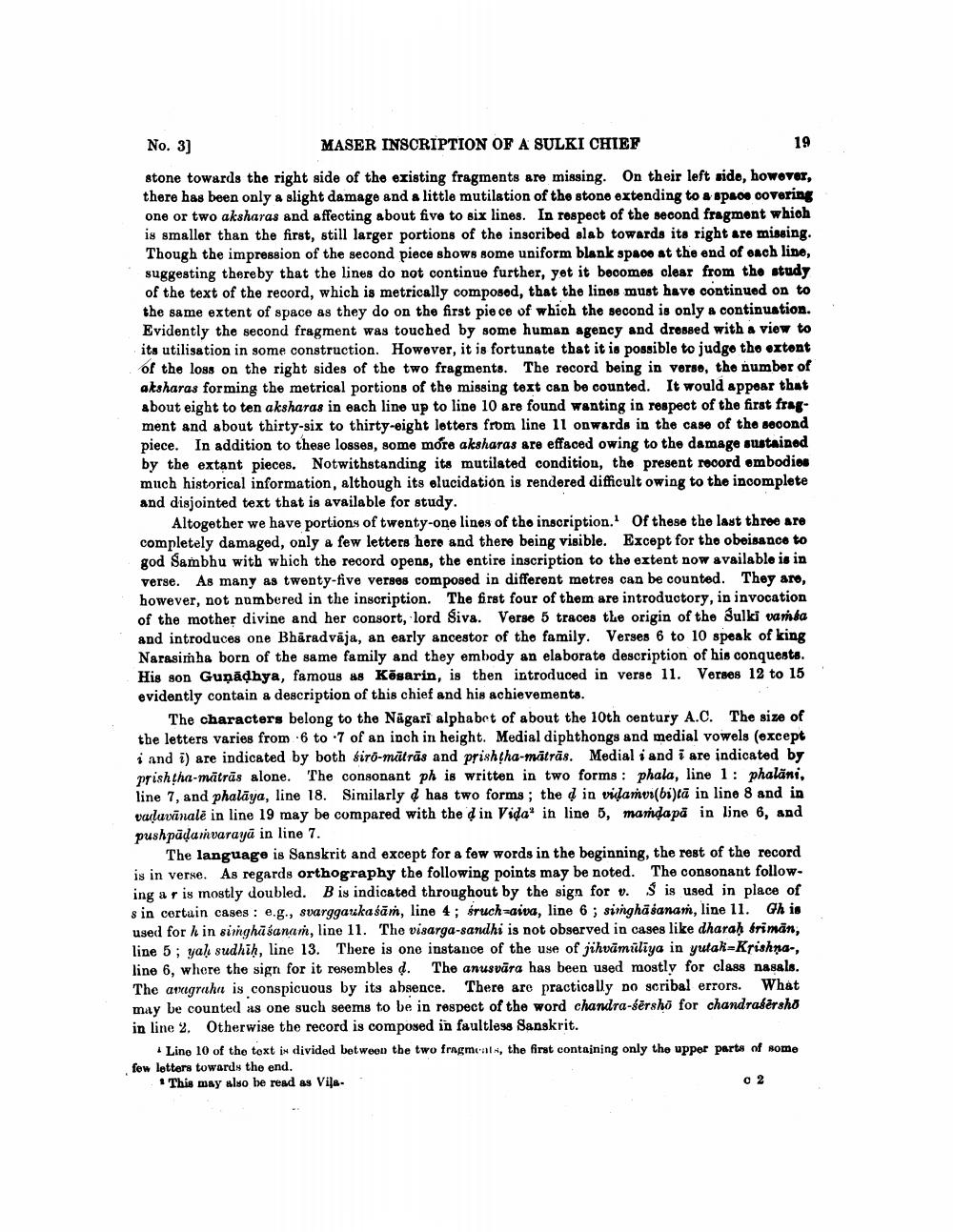________________
19
No. 3]
MASER INSCRIPTION OF A SULKI CHIEF stone towards the right side of the existing fragments are missing. On their left side, however, there has been only a slight damage and a little mutilation of the stono extending to a spa. covering one or two aksharas and affecting about five to six lines. In respect of the second fragment which is smaller than the first, still larger portions of the inscribed slab towards its right are missing. Though the impression of the second piece shows some uniform blank space at the end of each line, suggesting thereby that the lines do not continue further, yet it becomes clear from the study of the text of the record, which is metrically composed, that the lines must have continued on to the same extent of space as they do on the first piece of which the second is only a continuation. Evidently the second fragment was touched by some human agency and dressed with a view to its utilisation in some construction. However, it is fortunate that it is possible to judge the extont of the loss on the right sides of the two fragments. The record being in vorse, the number of aksharas forming the metrical portions of the missing text can be counted. It would appear that about eight to ten aksharas in each line up to line 10 are found wanting in respect of the first frage ment and about thirty-six to thirty-eight letters from line 11 onwards in the case of the second piece. In addition to these losses, some more aksharas are effaced owing to the damage sustained by the extant pieces. Notwithstanding its mutilated condition, the present record ombodios much historical information, although its elucidation is rendered difficult owing to the incomplete and disjointed text that is available for study.
Altogether we have portions of twenty-one lines of the inscription. Of these the last three are completely damaged, only a few letters here and there being visible. Except for the obeisance to god Sambhu with which the record opens, the entire inscription to the extent now available is in verse. As many as twenty-five verses composed in different metres can be counted. They are, however, not numbered in the inscription. The first four of them are introductory, in invocation of the mother divine and her consort, lord Siva. Verse 5 traces the origin of the Sulki vanda and introduces one Bhäradvāja, an early ancestor of the family. Verses 6 to 10 speak of king Narasimha born of the same family and they embody an elaborate description of his conquests. His son Gunādhya, famous as Kõgarin, is then introduced in verse 11. Verses 12 to 15 evidently contain a description of this chief and his achievements.
The characters belong to the Nagari alphabet of about the 10th century A.C. The size of the letters varies from 6 to 7 of an inch in height. Medial diphthongs and medial vowels (except i and i) are indicated by both siro-mitrās and prishtha-mātrās. Medial i and i are indicated by prishtha-mātrās alone. The consonant ph is written in two forms: phala, line 1: phalani. line 7, and phalāya, line 18. Similarly d has two forms; the din viamvi(bi)tà in line 8 and in valuuvinale in line 19 may be compared with the din Vida' in line 5, mandapă in line 6, and pushpādarvaraya in line 7.
The language is Sanskrit and except for a few words in the beginning, the rest of the record is in verse. As regards orthography the following points may be noted. The consonant following a r is mostly doubled. B is indicated throughout by the sign for v. S is used in place of s in certain cases : e.g., svarggaukasan, line 4 ; śruch-aiva, line 6; singhäsanan, line 11. Gh is used for h in singhāśanam, line 11. The visarga-sandhi is not observed in cases like dharah friman, line 5; yal sudhih, line 13. There is one instance of the use of jihvūmaliya in yutal-Krishna-, line 6, where the sign for it resembles d. The anusvāra has been used mostly for class nasals. The anugraha is conspicuous by its absence. There are practically no scribal errors. What may be counted as one such seems to be in respect of the word chandra-sërsho for chandrafërsho in line 2. Otherwise the record is composed in faultless Sanskrit.
Line 10 of the text is divided between the two fragmeals, the first containing only the upper parts of some few letters towards the end. This may also be read as Vils.
O 2




